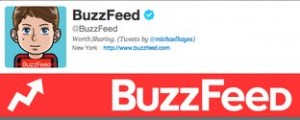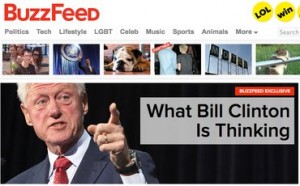Brands
BuzzFeed’s Social Media Editor on Why Twitter is the New Press Scrum
This post is part of the Social Media Editor Series, featuring interviews with social media editors from news organizations about what they do and where they see social media in journalism going.
Michael Hayes’ ambition to make BuzzFeed the number one social news organization is predicated on the idea that social media is the new news.
 “Twitter is the new press scrum,” BuzzFeed’s social media editor told The Content Strategist. “It’s the place where news goes to break first.”
“Twitter is the new press scrum,” BuzzFeed’s social media editor told The Content Strategist. “It’s the place where news goes to break first.”
He’s not wrong.
The world of news has largely become intertwined with that of social media, so much so that Hayes said BuzzFeed readers come to the site — or, more appropriately, to its Twitter feed — with the intention of sharing media. The BuzzFeed staff curates viral content with the idea that such content is what people inherently want to read about.
“Basically we want to be a device for people to share news and content with friends,” Hayes said, “because that’s how people prefer to get their news these days.”
His work day involves trudging through social media and content on two computer screens, one dedicated exclusively to TweetDeck. Appropriately, BuzzFeed’s posts are short and sweet and made for sharing, not just driving people to the site (which at 25 million unique monthly visitors happens plenty anyway).

And BuzzFeed is growing. Since Hayes, a Fordham University communications graduate, began working there a year and a half ago, the staff has gone from 25 to 140. The editorial team — which like many news organizations also includes the social media editor — recently moved to a second floor in Buzz Feed’s Flat Iron office building.
That growth is partly from doing what readers want.
“People sign up for a social network because they want to be on that network,” Hayes, a 28-year-old Brooklyn resident, said. “They don’t want to constantly be sent away from Twitter.”
If news story breaks, BuzzFeed will often send out a slew of tweets immediately, before putting up a post. For traditionalists, this might sound like a media company scooping itself — but it’s really just finding what’s already on social media anyway and pushing it out to its audience.
That doesn’t mean BuzzFeed isn’t trying to drive traffic to its own site — it absolutely is, posting approximately 40 to 50 links to its site a day.
 “Beyond that, we also do other stuff so people like us more on Twitter,” he said.
“Beyond that, we also do other stuff so people like us more on Twitter,” he said.
For Hayes, who formerly worked at a PR firm, that sometimes means no links to the site at all.
For example, when the space shuttle Enterprise flew over Manhattan in April, it seemed like everyone in New York City, including news organizations, was posting pictures of the shuttle as it crossed the city skyline.
To add to what was clearly a shared social moment, Hayes tweeted: “Retweet this if you ever wanted to be an astronaut.” It was retweeted nearly 900 times. What the retweets, in effect, show are what types of posts are popular — and as content strategists know, those are frequently articles that evoke an emotional response.
BuzzFeed espouses a Tweet first, post later mentality, to keep up with the ever-speedy news cycle. Such was the case the day of the Empire State Building shootings in August, when BuzzFeed sent out more than a dozen tweets before it even posted on its website.
“The news was breaking on Twitter, so it was important for us to be a part of that conversation so that we knew what was happening in real-time,” Hayes said.
 After BuzzFeed’s post was up, Hayes continued to retweet people on the scene, news reports and even updates to the post. Writing about what is popular may seem backward to traditional journalists — as do many things about BuzzFeed.
After BuzzFeed’s post was up, Hayes continued to retweet people on the scene, news reports and even updates to the post. Writing about what is popular may seem backward to traditional journalists — as do many things about BuzzFeed.
A notable example of this was when a writer from Slate found that many of BuzzFeed’s highly popular lists, as well as some text, were taken from other sites without accreditation, (These posts have since been updated with sources.)
Hayes said Politico’s Ben Smith, who took the editorial helm at the start of the year, is bringing the organization in a more journalistic direction — which to Hayes is inseparable from social media.
Hayes was also quick to dismiss the sourcing controversy by referring to his ethos for tweets, saying that BuzzFeed has moved on.
“Twitter doesn’t want to be spit back to itself,” he said. “We’re looking for the next step in the conversation.”
Get better at your job right now.
Read our monthly newsletter to master content marketing. It’s made for marketers, creators, and everyone in between.




